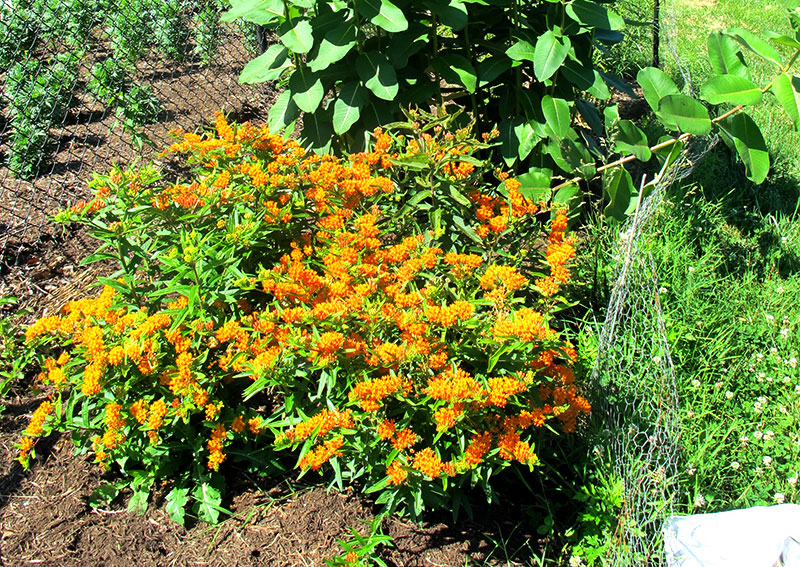
The monarch butterfly population hit an all-time low around 2014. The loss of milkweed, which was once a common sight across America’s farm landscape, is a main factor in the monarch’s decline, or so it seems. Not many researchers have conducted studies to confirm this, and even fewer have delved into the details of which species of milkweed monarch caterpillars favor in a typical residential garden setting (rather than a lab or greenhouse).
University of Kentucky researchers Adam Baker and Daniel Potter have explored how the species selection and planting configuration of milkweeds affects monarch visitation. Monarchs are specialists, and they rely on that special plant to support the next generation. In the midst of a bountiful, colorful garden, can the butterflies locate milkweed when it’s time to deposit their eggs? Will the eggs survive into growing caterpillars that munch on the somewhat toxic milkweed, making them foul-tasting to predators? Which types of milkweed work best for them?
Baker and Potter studied more than just common milkweed (Asclepias syriaca). Their experimental garden plots included eight species. In 2016 and 2017, they observed monarch behavior and bee attraction to the plants. Their study also compared the survival of monarch caterpillars on different types of milkweed.
Their two-year study, recently published in the Journal of Insect Conservation, is summed up here: “More eggs and larvae were found on taller, broad-leaved milkweeds, but there was relatively little difference in larval performance, suggesting ovipositional [egg-laying] preference for more apparent plants. Asclepias tuberosa [butterfly weed] and A. fascicularis [narrow leaf milkweed] attracted the greatest number of bees, whereas bee genus diversity was greatest on A. verticillata [eastern whorled milkweed], A. fascicularis and A. tuberosa.”
Baker and Porter identified a lot of bee species, including 17 types of honeybees, carpenter bees, bumblebees, ground-nesting bees, plasterer bees, sweat bees and leafcutter bees. In layman’s terms, the favorite milkweeds for the bees were:

- The vibrant orange butterfly weed (A. tuberosa, shown above).
- The taller, delicate and unassuming narrow leaf milkweed, aka Mexican whorled milkweed (A. fascicularis) and the similar eastern whorled milkweed (A. verticillata). This one is great for hosting late-season migrating monarchs because its blooms last until late fall.
Best monarch-supporting milkweeds proved to be the biggest and tallest species:
- The good old common milkweed (A. syriaca, shown in the photo below).
- The slightly hairier cousin, showy milkweed (A. speciosa).

The researchers’ paper states, “Combining milkweeds that are preferred by ovipositing monarchs with ones that are particularly attractive to bees may enhance conservation value of small urban gardens.” If you want the most cost-effective option for your pollinator garden, “Planting milkweed species that attract and sustain bees as well as monarchs could boost the conservation value of gardens at no additional cost.”
Where you plant milkweed could make a difference as well. While Baker and Potter have not published their research on plant placement yet, they write, “Short-statured milkweeds may go unnoticed by butterflies in mixed gardens because they are less apparent than taller milkweeds when surrounded by non-host plants.” They have observed more monarch eggs clustered on plants along garden edges, even when more milkweed is available in the garden’s interior.
Milkweed has a much more complex relationship with plant-eaters against which it has evolved to defend itself. Baker and Potter explain, “Milkweed defenses are dynamic and change with plant age and condition, and in response to herbivory, and they interact with plant height, architecture and leaf morphology, and with natural enemies, to influence monarch behavior and performance.” The researchers conclude that all eight species of milkweed they studied support growth and health of caterpillars equally, so the choice of the butterflies to place their eggs on certain species is still somewhat unknown, but is more likely related to the plants along the edges of the gardens being an easier landing spot.
In short, if you start a new pollinator garden or just want to include milkweed in your garden, the best species for monarchs and bees are the ones listed above, and the best place to put them is at the outer edges of the garden. While this study was conducted in central Kentucky, three of the eight milkweed species evaluated were not native to the region. Become a citizen scientist and try this research yourself. Home gardeners can make their own observations on various plants and notice what is most popular to their pollinator friends. Watch flies, bees, beetles, wasps, moths and butterflies closely as they visit flowers. Then take a quick count, and try to distinguish how many different insects are on each type of plant. Remember to look underneath leaves for insect eggs and tiny caterpillars. Planting milkweed is rewarding, whether you study it or not. It is a simple way the average gardener can do something about a continental collapse of an important and iconic member of our ecosystem.
For more information on establishing a monarch waystation, visit Monarch Watch. To report sightings of monarchs on their migration, visit Journey North. To read more the entire paper and learn more about Baker and Potter’s research, click here.




